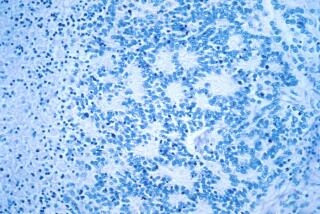First clinical trial begins for stem cell therapy
- Share via
Researchers announced Monday that they had injected stem cells into a patient with a spinal cord injury on Friday, kicking off the world’s first clinical trial of a therapy derived from human embryonic stem cells.
The patient was treated at Shepherd Center, a spinal cord and brain injury center in Atlanta.
Though the trial, run by Geron Corp. of Menlo Park, Calif., is in its earliest stages — aimed primarily at testing the treatment for safety — the event stands as a landmark one for embryonic stem cell researchers, who for years have studied the cells’ potential to treat spinal cord injuries, diabetes and a variety of neurodegenerative diseases.
“All of that work, all of that money sent to the ivory towers is manifesting something. It’s a real shot in the arm for the field,” said Hans Keirstead, a neurobiologist at the Reeve-Irvine Research Center at UC Irvine who led a team that pioneered the treatment in rats and licensed the technology to Geron.
Keirstead’s team managed first to turn human embryonic stem cells into oligodendrocytes, the cells that insulate nerve fibers with coatings of fatty myelin. Growing the “tubing” that protects nerve cells could in many cases be enough to allow signals to travel up and down the spine again, Keirstead said. That’s because, in the vast majority of spinal cord injuries, the cord is not completely severed — rather, the myelin sheath that protects the nerve cells is damaged or destroyed.
In the animal trials, rats with spinal cord damage that had lost control of their hind limbs regained at least the partial ability to walk and run after treatments with the stem cells.
The human trial is a so-called Phase I trial, meant to test the safety of the treatment for people. It will enroll up to 10 patients who have suffered spinal cord injuries between the third and 10th thoracic vertebrae, injecting the cells within 14 days of the injury. If the treatment is shown to be safe and well tolerated, researchers will move on to test the treatment’s effectiveness.
In addition to the Shepherd Center, Northwestern University near Chicago has been announced as a site for this phase of the trial, and up to seven centers ultimately may be involved. The trial will last for two years after the last of the patients is enrolled.
Dr. Robert Watkins IV, an orthopedic spine surgeon and co-director of the Marina Spine Center at Marina Del Rey Hospital, said even the start of a Phase I trial in this area of medicine is encouraging.
“We know a lot about rehabilitation … but right now we have no treatment,” Watkins said. “It’s one of the most frustrating aspects of being a doctor.”
Keirstead said that even if the therapy ultimately did not permit people to walk and run again, it might greatly improve their quality of life by giving them more control over bowel, bladder and sexual functions.
He said he would be “waiting with bated breath every day” of the trial, watching for any side effects, such as signs of tumor growth or pain.
“I’ve got a couple of years of waking up and looking at the news every day, hoping and praying we’re doing good for people and not bad,” he said.
amina.khan@latimes.com







